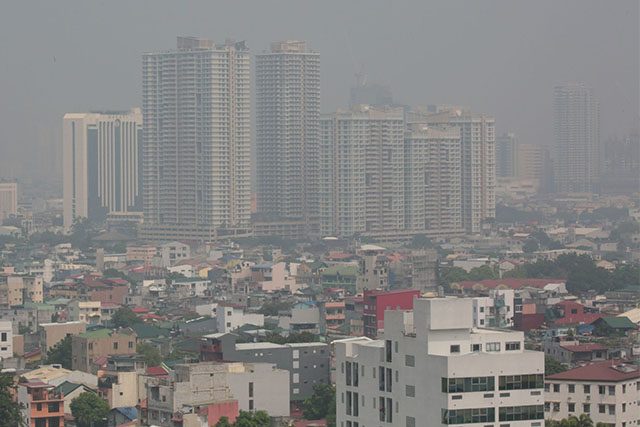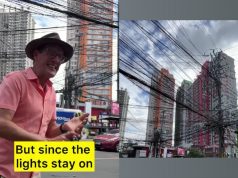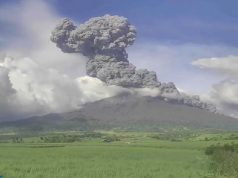
“Final answer?”
State volcanologists finally acknowledged that volcanic smog or vog from Taal Volcano has spread over Metro Manila and adjoining provinces after mainly attributing the smog to human activities before.
The Philippine Institute of Volcanology and Seismology on Wednesday said that there is evidence sulfur dioxide plumes from the Batangas-based volcano have reached other areas based on satellite information on June 28 and 29.
The volcano is currently on Alert Level 2.
Retrieved data showed that its plumes extended from the planetary boundary layer to the upper troposphere at almost 20 kilometers above sea level.
Satellite detection on June 29 showed an even larger coverage of Luzon Island.
The plumes initially reached Batangas, Cavite, Laguna, Rizal, Bulacan, Pampanga, Zambales and Manila on Monday.
On Tuesday, it reached the provinces of Batangas, Cavite, Laguna, Rizal, Quezon, Camarines Norte, Camarines Sur, Bulacan, Bataan, Pampanga, Zambales, Pangasinan, Tarlac, La Union, Benguet, Nueva Vizcaya, Quirino, Aurora and Metro Manila.
“These data confirm our observation of volcanic smog or vog over the Taal Region for which we released an advisory at 6 A.M. on 28 June 2021, prior to recording the highest SO2 (sulfur dioxide) flux at 14,326 tonnes/day. Since then, inquiries have been made by the public about the presence of sulfur dioxide and vog in Metro Manila and the surrounding provinces based on their observations of haze,” the institute said.
Taal Volcano is around 60 kilometers south of Metro Manila.
“Our Institute had initially negated these observations due to the lack of substantiating evidence on our part and the general direction of wind and SO2 dispersal from Taal to the northeast and east since 28 June 2021,” Phivolcs added.
“We also released statements that the haze over Metro Manila is mainly due to smog from human activities, interpretation which is supported by information from DOST-PAGASA that the presence of a warm layer of air at elevations of less than one (1) kilometer is preventing cooler air near the ground to rise, trapping pollutants and helping promote the accumulation of smog over NCR and nearby provinces,” it further said.
The institute added that the incident served as a reminder that its data has “value of uncertainty” and “limitations.”
Phivolcs added that it is also a reminder of “the value of citizen observation” and that there is a “need to constantly challenge” its own perceptions, interpretations and ideas.
“We would like to reassure the public that we are committed to provide the best and most current volcano monitoring data available, especially that these have important safety and health implications,” the institute said.
It also shared satellite images on its Facebook page which showed the coverage of the sulfur dioxide plumes
On Tuesday, several Filipinos expressed that they were confused by the Phivolcs’ statement which attributed the haze experienced over the metro as air pollution.
READ: ‘Caused by human activity’: Why Phivolcs’ statement on Metro Manila haze confused social media
The day before that, it reported vog observed over Taal Volcano but didn’t mention that the vog affects Metro Manila.
Reports, however, correlated the two, prompting the local online community to express confusion.
On Wednesday, Phivolcs said that sulfur dioxide plumes have indeed reached the capital region and other provinces in Luzon based on satellite data.
Some social media users quipped if it was the institute’s “final answer” following the statement releases.
“Hanggulo niyo po, opo (crying face emoji). Sana final answer na ‘to,” a Twitter user wrote in response to Phivolcs’ latest advisory.
“Final answer?” asked another online user.
Others cosidered Phivolcs’ statement as an affirmation that it is the haze they have been experiencing in their respective areas.
“Bhie kahapon nga parang mausok na dito sa amin, wala naman nagsisiga,” a Twitter user commented.
“Di naman kasi talaga kapani-paniwala na smog lang ito. Sa 6 months ko dito, ngayon lang ganito ka polluted ang hangin for how many days,” another online user wrote, quote tweeting a video.
“Kaya pala kahit sobrang init, ma-foggy pa rin,” commented a different Filipino.
“Mahirap din kasi isipin na smog lang siya kasi parang 5-6 p.m. itsura sa labas nang tanghaling-tapat hahahaha,” likewise shared another Twitter user.
Amid the reported vog, Phivolcs advised Filipinos to stay indoors as much as possible, keep themselves hydrated and wear a face mask when heading out to avoid breathing in irritants from the atmosphere.









